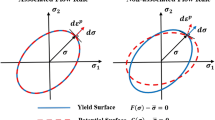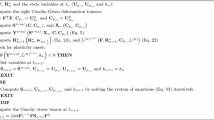Abstract
Background
The evolution of anisotropy has an important influence on the forming of parts under large deformation. However, most of the current yield criteria do not consider the evolution.
Objective
An anisotropic constitutive model based on non-associated flow rule (non-AFR) was established for orthotropic sheet metal. The classical quadratic Hill48 model was used to describe the yield anisotropy and plastic deformation anisotropy, respectively.
Methods
According to the principle of equivalent plastic work, the existence and significance of anisotropy evolution with plastic deformation were revealed. In order to improve the prediction accuracy of the model, a continuous capture scheme considering anisotropic hardening was proposed.
Results
The evolution of directional yield stress, directional r-value and yield locus was well captured by the developed model. To further verify the model, square box deep drawing tests of different strokes of the punch were carried out. Compared with the experimental results, the developed model could predict the material flow behavior in flange area and thickness thinning behavior, which actually reflected the evolution behavior of directional flow stress and directional r-value of sheet metal respectively.
Conclusion
The developed model improves the prediction accuracy of anisotropic sheet metal forming, and can provide an effective reference scheme for large deformation problems in industrial production.






















Similar content being viewed by others
Data Availability
The authors confirm that the data supporting the findings of this study are available within the article.
Abbreviations
- \(\phi\) :
-
Yield criteria
- σ :
-
Cauchy stress tensor
- \(\bar \sigma ({\bar \varepsilon_p})\) :
-
Equivalent stress-strain relationship of uniaxial tension
- \({\bar \varepsilon_p}\) :
-
Equivalent plastic strain
- \({f_y}\) :
-
Equivalent stress of yield function
- \({f_p}\) :
-
Equivalent stress of potential function
- \(\boldsymbol d{\boldsymbol\varepsilon}_p\) :
-
Plastic strain increment
- \(d\lambda\) :
-
Plastic multiplier increment
- m :
-
First order gradient of the yield function
- n :
-
First order gradient of the potential function
- dw :
-
Equivalent plastic work increment
- d σ :
-
Stress tensor increment
- \({\boldsymbol C}_{e}\) :
-
Elastic stiffness matrix
- \(\boldsymbol d{\boldsymbol\varepsilon}_e\) :
-
Elastic strain increment
- \(\boldsymbol d\boldsymbol\varepsilon\) :
-
Strain tensor increment
- F σ, G σ, H σ, L σ, M σ, N σ :
-
Anisotropic parameters of yield function
- F r, G r, H r, L r, M r, N r :
-
Anisotropic parameters of potential function
- X:Y :
-
Tensor double contraction operation of X and Y
References
Banabic D, Kuwabara T, Balan T, Comsa DS, Julean D (2003) Non-quadratic yield criterion for orthotropic sheet metals under plane-stress conditions. Int J Mech Sci 45(5):797–811. https://doi.org/10.1016/S0020-7403(03)00139-5
Banabic D, Aretz H, Comsa DS, Paraianu L (2005) An improved analytical de scription of orthotropy in metallic sheets. Int J Plast 21(3):493–512. https://doi.org/10.1016/j.ijplas.2004.04.003
Barlat F, Lian J (1989) Plastic behavior and stretchability of sheet metals, Part I: a yield function for orthotropic sheets under plane stress conditions. Int J Plast 5:51–66. https://doi.org/10.1016/0749-6419(89)90019-3
Barlat F, Lege DJ, Brem JC (1991) A six-component yield function for anisotropic materials. Int J Plast 7(7):693–712. https://doi.org/10.1016/0749-6419(91)90052-Z
Barlat F, Maeda Y, Chung K, Yanagawa M, Brem JC, Hayashida Y, Makosey S (1997) Yield function development for aluminum alloy sheets. J Mech Phys Solids 45(11–12):1727–1763. https://doi.org/10.1016/S0022-5096(97)00034-3
Barlat F, Brem JC, Yoon JW, Chung K, Dick RE, Lege DJ, Chu E (2003) Plane stress yield function for aluminum alloy sheets – Part 1: Theory. Int J Plast 19(9):1297–1319. https://doi.org/10.1016/S0749-6419(02)00019-0
Barlat F, Aretz H, Yoon JW, Karabin ME, Brem JC, Dick RE (2005) Linear transformation-based anisotropic yield functions. Int J Plast 21(5):1009–1039. https://doi.org/10.1016/j.ijplas.2004.06.004
Barlat F, Yoon JW, Cazacu O (2007) On linear transformations of stress tensors for the description of plastic anisotropy. Int J Plast 23(5):876–896. https://doi.org/10.1016/j.ijplas.2006.10.001
Cazacu O, Plunkett B, Barlat F (2006) Orthotropic yield criterion for hexagonal closed packed metals. Int J Plast 22(7):1171–1194. https://doi.org/10.1016/j.ijplas.2005.06.001
Cvitanić V, Vlak F, Lozina Ž (2008) A finite element formulation based on non-associated plasticity for sheet metal forming. Int J Plast 24:646–687. https://doi.org/10.1016/j.ijplas.2007.07.003
Du K, Huang S, Hou Y, Wang H, Wang Y, Zheng W (2023) Characterization of the asymmetric evolving yield and flow of 6016–t4 aluminum alloy and dp490 steel. J Mater Sci Technol 154:103302. https://doi.org/10.1016/j.jmst.2022.05.040
Gao X, Zhang T, Zhou J, Graham SM, Hayden M, Roe C (2011) On stress-state dependent plasticity modeling: significance of the hydrostatic stress, the third invariant of stress deviator and the non-associated flow rule. Int J Plast 27(2):217–231. https://doi.org/10.1016/j.ijplas.2010.05.004
Gawad J, Banabic D, Van BA, Comsa DS, Gologanu M, Eyckens P, Roose D (2015) An evolving plane stress yield criterion based on crystal plasticity virtual experiments. Int J Plast 75:141–169. https://doi.org/10.1016/j.ijplas.2015.02.011
Hill R (1948) A theory of the yielding and plastic flow of anisotropic metals. Math Proc Cambridge Philos Soc 193:281–297. https://doi.org/10.1098/rspa.1948.0045
Hill R (1979) Theoretical plasticity of textured aggregates. Math Proc Cambridge Philos Soc 85(01):179–191. https://doi.org/10.1017/S0305004100055596
Hill R (1990) Constitutive modelling of orthotropic plasticity in sheet metals. J Mech Phys Solids 38(3):405–417. https://doi.org/10.1016/0022-5096(90)90006-P
Hill R (1993) A user-friendly theory of orthotropic plasticity in sheet metals. Int J Mech Sci 35(1):19–25. https://doi.org/10.1016/0020-7403(93)90061-X
Hill R, Hutchinson JW (1992) Differential hardening in sheet-metal under biaxial loading–a Theoretical framework. J Appl Mech 59(2s):s1–s9. https://doi.org/10.1115/1.2899489
Hu W (2007) Constitutive modeling of orthotropic sheet metals by presenting hardening-induced anisotropy. Int J Plast 23:620–639. https://doi.org/10.1016/j.ijplas.2006.08.004
Karafillis AP, Boyce MC (1993) A general anisotropic yield criterion using bounds and a transformation weighting tensor. J Mech Phys Solids 41(12):1859–1886. https://doi.org/10.1016/0022-5096(93)90073-O
Khalfallah A, Alves JL, Oliveira MC, Menezes LF (2015) Influence of the characteristics of the experimental data set used to identify anisotropy parameters. Simul Model Pract Theory 53:15–44. https://doi.org/10.1016/j.simpat.2015.02.007
Khalfallah A, Oliveira MC, Alves JL, Menezes LF (2020) Constitutive parameter identification of CB2001 yield function and its experimental verification using tube hydroforming tests. Int J Mech Sci 185:105868. https://doi.org/10.1016/j.ijmecsci.2020.105868
Lee EH, Stoughton TB, Yoon JW (2017) A yield criterion through coupling of quadratic and non-quadratic functions for anisotropic hardening with non-associated flow rule. Int J Plast 99:120–143. https://doi.org/10.1016/j.ijplas.2017.08.007
Lou Y, Whan J (2018) Anisotropic yield function based on stress invariants for BCC and FCC metals and its extension to ductile fracture criterion. Int J Plast 101:125–155. https://doi.org/10.1016/j.ijplas.2017.10.012
Lou Y, Huh H, Whan J (2013) Consideration of strength differential effect in sheet metals with symmetric yield functions. Int J Mech Sci 66:214–223. https://doi.org/10.1016/j.ijmecsci.2012.11.010
Min J, Carsley JE, Lin J, Wen Y, Kuhlenkötter B (2016) A non-quadratic constitutive model under non-associated flow rule of sheet metals with anisotropic hardening: Modeling and experimental validation. Int J Mech Sci 119:343–359. https://doi.org/10.1016/j.ijmecsci.2016.10.027
Mu Z, Zhao J, Meng Q, Sun H, Yu G (2022) Anisotropic hardening and evolution of r-values for sheet metal based on evolving non-associated Hill48 model. Thin-Walled Struct 171:108791. https://doi.org/10.1016/j.tws.2021.108791
Park N, Stoughton TB, Yoon JW (2019) A criterion for general description of anisotropic hardening considering strength differential effect with non-associated flow rule. Int J Plast 121:76–100. https://doi.org/10.1016/j.ijplas.2019.04.015
Prates PA, Oliveira MC, Fernandes JV (2014) A new strategy for the simultaneous identification of constitutive laws parameters of metal sheets using a single test. Comput Mater Sci 85:102–120. https://doi.org/10.1016/j.commatsci.2013.12.043
Prates PA, Oliveira MC, Fernandes JV (2016) Identification of material parameters for thin sheets from single biaxial tensile test using a sequential inverse identification strategy. IntJ Mater Form 9(4):547–571. https://doi.org/10.1007/s12289-015-1241-z
Safaei M, Lee M, Zang S, Waele WD (2014) An evolutionary anisotropic model for sheet metals based on non-associated flow rule approach. Comput Mater Sci 81:15–29. https://doi.org/10.1016/j.commatsci.2013.05.035
Shi B, Mosler J (2013) On the macroscopic description of yield surface evolution by means of distortional hardening models: Application to magnesium. Int J Plast 44:1–22. https://doi.org/10.1016/j.ijplas.2012.11.007
Smith J, Liu WK, Cao J (2015) A general anisotropic yield criterion for pressure-dependent materials. Int J Plast 75:2–21. https://doi.org/10.1016/j.ijplas.2015.08.009
Soare SC, Yoon JW, Cazacu O, Barlat F (2007) Applications of a recently proposed anisotropic yield function to sheet forming. In: Advanced Methods in Material Forming. Springer. https://doi.org/10.1007/3-540-69845-0_8
Spitzig WA, Richmond O (1984) The effect of pressure on the flow stress of metals. Acta Metall 32(3):457–463. https://doi.org/10.1016/0001-6160(84)90119-6
Stoughton TB (2002) A non-associated flow rule for sheet metal forming. Int J Plast 18(5–6):687–714. https://doi.org/10.1016/S0749-6419(01)00053-5
Stoughton TB, Yoon JW (2004) A pressure-sensitive yield criterion under a non-associated flow rule for sheet metal forming. Int J Plast 20(4–5):705–731. https://doi.org/10.1016/S0749-6419(03)00079-2
Stoughton TB, Yoon JW (2006) Review of Drucker’s postulate and the issue of plastic stability in metal forming. Int J Plast 22(3):391–433. https://doi.org/10.1016/j.ijplas.2005.03.002
Stoughton TB, Yoon JW (2008) On the existence of indeterminate solutions to the equations of motion under non-associated flow. Int J Plast 24(4):583–613. https://doi.org/10.1016/j.ijplas.2007.07.002
Stoughton TB, Yoon JW (2009) Anisotropic hardening and non-associated flow in proportional loading of sheet metals. Int J Plast 25:1777–1817. https://doi.org/10.1016/j.ijplas.2009.02.003
Taherizadeh A, Green DE, Yoon JW (2011) Evaluation of advanced anisotropic models with mixed hardening for general associated and non-associated flow metal plasticity. Int J Plast 27(11):1781–1802. https://doi.org/10.1016/j.ijplas.2011.05.001
Taherizadeh A, Green DE, Yoon JW (2010) A non-associated plasticity model with anisotropic and nonlinear kinematic hardening for simulation of sheet metal forming. Int J Solids Struct 69–70(2):370–382. https://doi.org/10.1016/j.ijsolstr.2015.05.013
Wu B, Ito K, Mori N, Oya T, Taylor T, Yanagimoto J (2019) Constitutive equations based on non-associated flow rule for the analysis of forming of anisotropic sheet metals. Int J Precis Eng Manuf-Green Technol 7(2):465–480. https://doi.org/10.1007/s40684-019-00032-5
Wu B, Wang H, Taylor T, Yanagimoto J (2020) A non-associated constitutive model considering anisotropic hardening for orthotropic anisotropic materials in sheet metal forming. Int J Mech Sci 169:105320. https://doi.org/10.1016/j.ijmecsci.2019.105320
Yoon JW, Lou Y, Yoon J, Glazoff MV (2014) Asymmetric yield function based on the stress invariants for pressure sensitive metals. Int J Plast 56:184–202. https://doi.org/10.1016/j.ijplas.2013.11.008
Yoshida F, Hamasaki H, Uemori T (2015) Modeling of anisotropic hardening of sheet metals including description of the Bauschinger effect. Int J Plast 75:170–188. https://doi.org/10.1016/j.ijplas.2015.02.004
Funding
This project was funded and supported by National Natural Science Foundation of China (51975509 and 52205353).
Author information
Authors and Affiliations
Corresponding authors
Ethics declarations
Conflict of Interest
The authors declare that they have no conflict of interest.
Additional information
Publisher's Note
Springer Nature remains neutral with regard to jurisdictional claims in published maps and institutional affiliations.
Rights and permissions
Springer Nature or its licensor (e.g. a society or other partner) holds exclusive rights to this article under a publishing agreement with the author(s) or other rightsholder(s); author self-archiving of the accepted manuscript version of this article is solely governed by the terms of such publishing agreement and applicable law.
About this article
Cite this article
Zhang, Y., Duan, Y., Mu, Z. et al. Non-Associated Flow Rule Constitutive Modeling Considering Anisotropic Hardening for the Forming Analysis of Orthotropic Sheet Metal. Exp Mech 64, 305–323 (2024). https://doi.org/10.1007/s11340-024-01032-6
Received:
Accepted:
Published:
Issue Date:
DOI: https://doi.org/10.1007/s11340-024-01032-6




